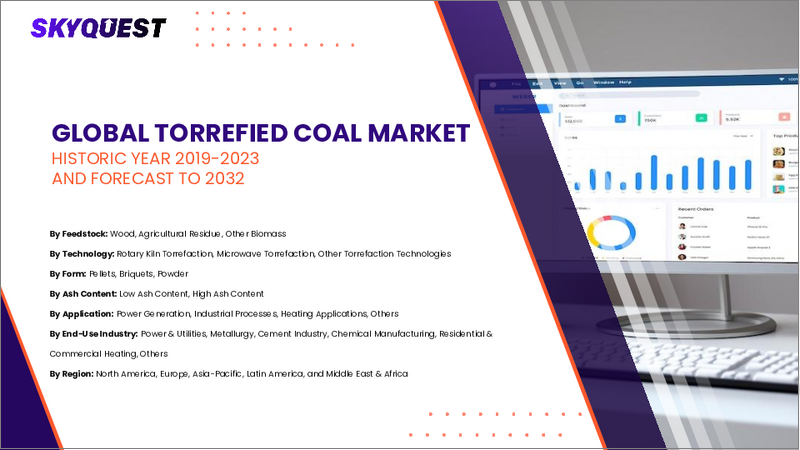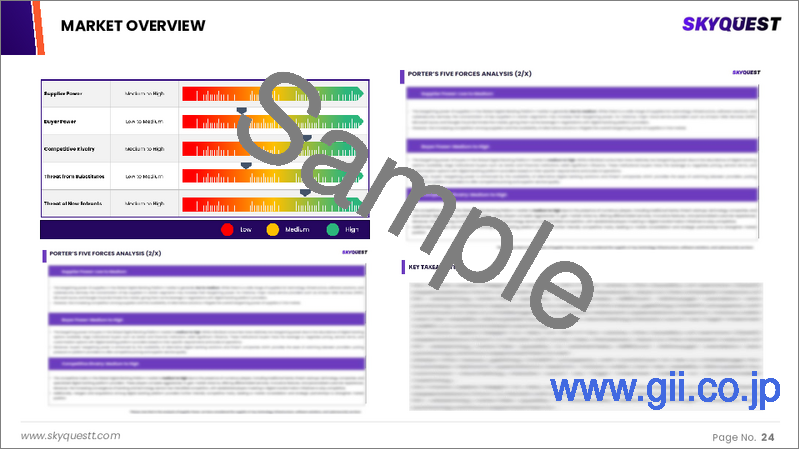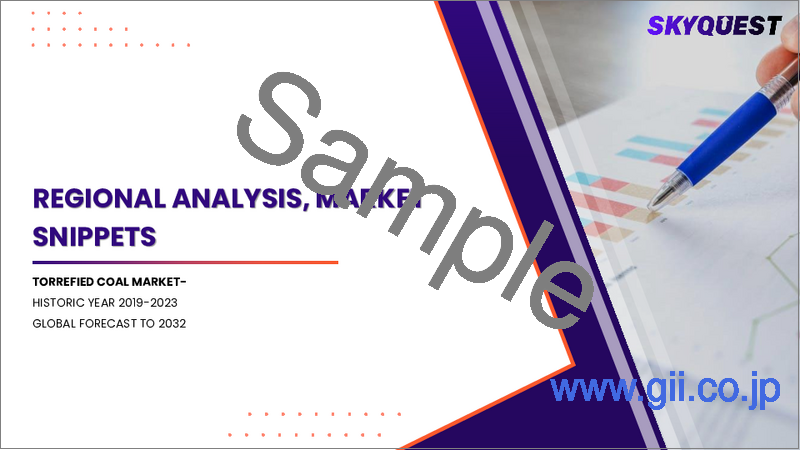|
|
市場調査レポート
商品コード
1643688
焙焼石炭の市場規模、シェア、成長分析:技術別、原料別、形態別、灰分含有量別、用途別、地域別 - 産業予測、2025年~2032年Torrefied Coal Market Size, Share, Growth Analysis, By Technology (Microwave Torrefaction, Rotary Kiln Torrefaction), By Feedstock (Wood, Agricultural Residue), By Form, By Ash Content, By Application, By Region - Industry Forecast 2025-2032 |
||||||
|
|||||||
| 焙焼石炭の市場規模、シェア、成長分析:技術別、原料別、形態別、灰分含有量別、用途別、地域別 - 産業予測、2025年~2032年 |
|
出版日: 2025年01月22日
発行: SkyQuest
ページ情報: 英文 261 Pages
納期: 3~5営業日
|
全表示
- 概要
- 目次
焙焼石炭市場規模は2023年に323億米ドルと評価され、2024年の378億6,000万米ドルから2032年には1,347億6,000万米ドルに成長し、予測期間(2025-2032年)のCAGRは17.2%で成長する見通しです。
焙焼石炭は、高いエネルギー密度、ハンドリングの改善、排出ガスの削減、持続可能性など、数多くの利点があるため、主要な代替燃料として急速に普及しています。未処理のバイオマスよりも高いエネルギー濃度を誇る焙焼石炭は、同じエネルギー出力に必要な体積を最小限に抑える効率的な燃料です。水分や不純物を除去して価値を高める乾留処理により、既存の石炭火力発電所と互換性のある製品が得られます。この互換性により、焙焼石炭へのシームレスな移行が可能になり、他の再生可能エネルギーに必要なコストのかかるインフラ投資を避けることができます。さらに、焙焼石炭の低含水率と優れた炭素水素比は、より効率的な燃焼プロセスを促進し、温室効果ガス排出量の大幅な削減につながるため、焙焼石炭はエネルギー部門にとって魅力的で環境に優しい選択肢となります。
目次
イントロダクション
- 調査の目的
- 調査範囲
- 定義
調査手法
- 情報調達
- 二次データと一次データの方法
- 市場規模予測
- 市場の前提条件と制限
エグゼクティブサマリー
- 世界市場の見通し
- 供給と需要の動向分析
- セグメント別機会分析
市場力学と見通し
- 市場概要
- 市場規模
- 市場力学
- 促進要因と機会
- 抑制要因と課題
- ポーターの分析
主な市場の考察
- 重要成功要因
- 競合の程度
- 主な投資機会
- 市場エコシステム
- 市場の魅力指数(2024年)
- PESTEL分析
- マクロ経済指標
- バリューチェーン分析
- 価格分析
- ケーススタディ
焙焼石炭市場規模:技術別& CAGR(2025-2032)
- 市場概要
- マイクロ波焙焼
- ロータリーキルン焙焼
焙焼石炭市場規模:原料別& CAGR(2025-2032)
- 市場概要
- 木材
- 農業残渣
焙焼石炭市場規模:形態別& CAGR(2025-2032)
- 市場概要
- ペレット
- ブリケット
- 粉末
焙焼石炭市場規模:灰分含有量別 & CAGR(2025-2032)
- 市場概要
- 灰分含有量が多い
- 灰分含有量が少ない
焙焼石炭市場規模:用途別& CAGR(2025-2032)
- 市場概要
- 発電
- 産業プロセス
焙焼石炭市場規模:地域別& CAGR(2025-2032)
- 北米
- 米国
- カナダ
- 欧州
- ドイツ
- スペイン
- フランス
- 英国
- イタリア
- その他欧州地域
- アジア太平洋地域
- 中国
- インド
- 日本
- 韓国
- その他アジア太平洋地域
- ラテンアメリカ
- ブラジル
- その他ラテンアメリカ地域
- 中東・アフリカ
- GCC諸国
- 南アフリカ
- その他中東・アフリカ
競合情報
- 上位5社の比較
- 主要企業の市場ポジショニング(2024年)
- 主な市場企業が採用した戦略
- 市場の最近の動向
- 企業の市場シェア分析(2024年)
- 主要企業の企業プロファイル
- 会社概要
- 製品ポートフォリオ分析
- セグメント別シェア分析
- 収益の前年比比較(2022-2024)
主要企業プロファイル
- ECN(Netherlands)
- Blackwood Technology(Netherlands)
- Steeper Energy Aps(Denmark)
- Nippon Steel Engineering Co. Ltd.(Japan)
- Boral Limited(Australia)
- Arbaflame AS(Norway)
- Green Flame Pte. Ltd.(Singapore)
- Airex Energy Inc.(Canada)
- FutureCarbon GmbH(Germany)
- Agri-Tech Producers LLC(United States)
- Kior Inc.(United States)
- The Biochar Company(United States)
- Phoenix Energy(United States)
- Carbon Terra GmbH(Germany)
- Vaskiluodon Voima Oy(Finland)
- DONG Energy A/S(Denmark)(now known as Orsted A/S)
- Neste Oil Corporation(Finland)
- Archer Daniels Midland Company(United States)
結論と推奨事項
Torrefied Coal Market size was valued at USD 32.3 billion in 2023 and is poised to grow from USD 37.86 billion in 2024 to USD 134.76 billion by 2032, growing at a CAGR of 17.2% during the forecast period (2025-2032).
Torrefied coal is rapidly gaining traction as a leading alternative fuel due to its numerous advantages, including high energy density, improved handling, reduced emissions, and sustainability. Boasting a higher energy concentration than untreated biomass, torrefied coal is an efficient fuel that minimizes the volume needed for the same energy output. The torrefaction process enhances its value by removing moisture and impurities, resulting in a product compatible with existing coal-fired power plants. This compatibility allows for seamless transitions to torrefied coal, avoiding costly infrastructure investments required for other renewables. Furthermore, its low moisture content and superior carbon-to-hydrogen ratio facilitate a more efficient combustion process, leading to significantly lower greenhouse gas emissions, making torrefied coal an attractive and eco-friendly choice for the energy sector.
Top-down and bottom-up approaches were used to estimate and validate the size of the Torrefied Coal market and to estimate the size of various other dependent submarkets. The research methodology used to estimate the market size includes the following details: The key players in the market were identified through secondary research, and their market shares in the respective regions were determined through primary and secondary research. This entire procedure includes the study of the annual and financial reports of the top market players and extensive interviews for key insights from industry leaders such as CEOs, VPs, directors, and marketing executives. All percentage shares split, and breakdowns were determined using secondary sources and verified through Primary sources. All possible parameters that affect the markets covered in this research study have been accounted for, viewed in extensive detail, verified through primary research, and analyzed to get the final quantitative and qualitative data.
Torrefied Coal Market Segments Analysis
Global Torrefied Coal Market is segmented by Technology, Feedstock, Form, Ash Content, Application and region. Based on Technology, the market is segmented into Microwave Torrefaction and Rotary Kiln Torrefaction. Based on Feedstock, the market is segmented into Wood and Agricultural Residue. Based on Form, the market is segmented into Pellets, Briquets and Powder. Based on Ash Content, the market is segmented into High Ash Content and Low Ash Content. Based on Application, the market is segmented into Power Generation and Industrial Processes. Based on region, the market is segmented into North America, Europe, Asia Pacific, Latin America and Middle East & Africa.
Driver of the Torrefied Coal Market
The torrefied coal market is experiencing significant growth due to the implementation of increasingly stringent environmental regulations worldwide, which aim to curb greenhouse gas emissions and combat climate change. As a renewable energy alternative, torrefied coal produces fewer pollutants compared to conventional coal, rendering it an attractive option for power generation. International agreements, such as the Paris Agreement, have fueled the transition to cleaner energy sources and the urgent need to cut carbon emissions. Moreover, the torrefaction process enhances biomass by eliminating moisture and volatile organic compounds, resulting in a cleaner fuel that further minimizes emissions. This combination of a favorable emission profile and renewable characteristics positions torrefied coal as a sustainable solution aligned with evolving regulatory frameworks.
Restraints in the Torrefied Coal Market
The torrefied coal market faces notable challenges primarily due to the substantial capital investment required for production. While torrefied coal boasts benefits such as reduced emissions and enhanced energy density, the expense of erecting and managing torrefaction plants remains a significant obstacle. The production process entails drying, heating, and densifying raw biomass, necessitating specialized and costly equipment. The initial outlay for establishing a torrefaction facility can be considerable and may require several years before it turns profitable. Consequently, many companies, particularly smaller ones or those in regions with lower electricity prices, may hesitate to commit to the high capital costs, potentially stalling market growth.
Market Trends of the Torrefied Coal Market
The Torrefied Coal market is experiencing a notable upward trend, spurred by increased investments in torrefaction technology from governments, corporations, and investors alike. Recognizing its potential, these stakeholders are pouring resources into research and development, aiming to enhance the efficiency and cost-effectiveness of torrefied coal production. The process of torrefaction transforms biomass materials through low-oxygen heating, yielding an energy-dense and moisture-resistant fuel that serves as a sustainable alternative to conventional coal. This trend is further supported by the growing demand for cleaner energy solutions, as torrefied coal emits fewer pollutants and offers a lower environmental footprint, positioning it favorably in the renewable energy landscape.
Table of Contents
Introduction
- Objectives of the Study
- Scope of the Report
- Definitions
Research Methodology
- Information Procurement
- Secondary & Primary Data Methods
- Market Size Estimation
- Market Assumptions & Limitations
Executive Summary
- Global Market Outlook
- Supply & Demand Trend Analysis
- Segmental Opportunity Analysis
Market Dynamics & Outlook
- Market Overview
- Market Size
- Market Dynamics
- Drivers & Opportunities
- Restraints & Challenges
- Porters Analysis
- Competitive rivalry
- Threat of substitute
- Bargaining power of buyers
- Threat of new entrants
- Bargaining power of suppliers
Key Market Insights
- Key Success Factors
- Degree of Competition
- Top Investment Pockets
- Market Ecosystem
- Market Attractiveness Index, 2024
- PESTEL Analysis
- Macro-Economic Indicators
- Value Chain Analysis
- Pricing Analysis
- Case Studies
Global Torrefied Coal Market Size by Technology & CAGR (2025-2032)
- Market Overview
- Microwave Torrefaction
- Rotary Kiln Torrefaction
Global Torrefied Coal Market Size by Feedstock & CAGR (2025-2032)
- Market Overview
- Wood
- Agricultural Residue
Global Torrefied Coal Market Size by Form & CAGR (2025-2032)
- Market Overview
- Pellets
- Briquets
- Powder
Global Torrefied Coal Market Size by Ash Content & CAGR (2025-2032)
- Market Overview
- High Ash Content
- Low Ash Content
Global Torrefied Coal Market Size by Application & CAGR (2025-2032)
- Market Overview
- Power Generation
- Industrial Processes
Global Torrefied Coal Market Size & CAGR (2025-2032)
- North America (Technology, Feedstock, Form, Ash Content, Application)
- US
- Canada
- Europe (Technology, Feedstock, Form, Ash Content, Application)
- Germany
- Spain
- France
- UK
- Italy
- Rest of Europe
- Asia Pacific (Technology, Feedstock, Form, Ash Content, Application)
- China
- India
- Japan
- South Korea
- Rest of Asia-Pacific
- Latin America (Technology, Feedstock, Form, Ash Content, Application)
- Brazil
- Rest of Latin America
- Middle East & Africa (Technology, Feedstock, Form, Ash Content, Application)
- GCC Countries
- South Africa
- Rest of Middle East & Africa
Competitive Intelligence
- Top 5 Player Comparison
- Market Positioning of Key Players, 2024
- Strategies Adopted by Key Market Players
- Recent Developments in the Market
- Company Market Share Analysis, 2024
- Company Profiles of All Key Players
- Company Details
- Product Portfolio Analysis
- Company's Segmental Share Analysis
- Revenue Y-O-Y Comparison (2022-2024)
Key Company Profiles
- ECN (Netherlands)
- Company Overview
- Business Segment Overview
- Financial Updates
- Key Developments
- Blackwood Technology (Netherlands)
- Company Overview
- Business Segment Overview
- Financial Updates
- Key Developments
- Steeper Energy Aps (Denmark)
- Company Overview
- Business Segment Overview
- Financial Updates
- Key Developments
- Nippon Steel Engineering Co. Ltd. (Japan)
- Company Overview
- Business Segment Overview
- Financial Updates
- Key Developments
- Boral Limited (Australia)
- Company Overview
- Business Segment Overview
- Financial Updates
- Key Developments
- Arbaflame AS (Norway)
- Company Overview
- Business Segment Overview
- Financial Updates
- Key Developments
- Green Flame Pte. Ltd. (Singapore)
- Company Overview
- Business Segment Overview
- Financial Updates
- Key Developments
- Airex Energy Inc. (Canada)
- Company Overview
- Business Segment Overview
- Financial Updates
- Key Developments
- FutureCarbon GmbH (Germany)
- Company Overview
- Business Segment Overview
- Financial Updates
- Key Developments
- Agri-Tech Producers LLC (United States)
- Company Overview
- Business Segment Overview
- Financial Updates
- Key Developments
- Kior Inc. (United States)
- Company Overview
- Business Segment Overview
- Financial Updates
- Key Developments
- The Biochar Company (United States)
- Company Overview
- Business Segment Overview
- Financial Updates
- Key Developments
- Phoenix Energy (United States)
- Company Overview
- Business Segment Overview
- Financial Updates
- Key Developments
- Carbon Terra GmbH (Germany)
- Company Overview
- Business Segment Overview
- Financial Updates
- Key Developments
- Vaskiluodon Voima Oy (Finland)
- Company Overview
- Business Segment Overview
- Financial Updates
- Key Developments
- DONG Energy A/S (Denmark) (now known as Orsted A/S)
- Company Overview
- Business Segment Overview
- Financial Updates
- Key Developments
- Neste Oil Corporation (Finland)
- Company Overview
- Business Segment Overview
- Financial Updates
- Key Developments
- Archer Daniels Midland Company (United States)
- Company Overview
- Business Segment Overview
- Financial Updates
- Key Developments






